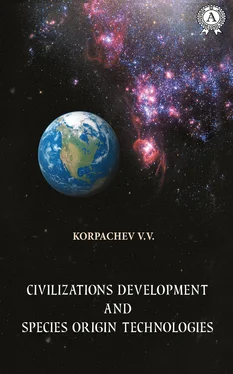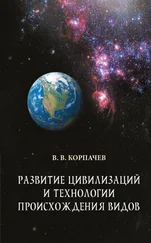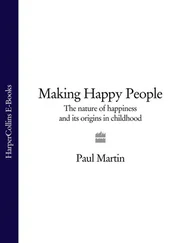The principle of reflection is characteristic for the matter at all levels of its organization and is the cornerstone of the materialist theory of cognition. Spontaneous development of the surrounding world occurs until the moment when material objects acquire the ability to think starting from the primitive responses to external stimuli formation to the information storage devices, the improvement of which can lead to the occurrence of intelligence, analytical abilities and adequate interaction with the environment. Then development takes on the features of awareness and controllability. Moreover, in addition to the passive adaptation to the changing external conditions, the former intelligence will consciously initiate further development of the surrounding world by planning and creating new materials and technologies in accordance with its needs.
Therefore, it is necessary to consider two stages in the spontaneous and self-organizing processes of the matter’s development – spontaneous (synergistic one) and managed by the developed intelligence’s one. Each of them has its fundamental features. On the initial stage there is a spontaneous complication of the physic-chemical structures until the initial intelligence’s occurrence capable of accumulating and analyzing information about the environment. On the second stage, the development of the material world is not a spontaneous one, but with the intelligent structures that carry out the activity aimed at their own life support. In this case, the environment changes already involuntarily. At this stage of development it is not the fortuity of the new material forms occurrence which will be observed but the design and expediency.
The possibility to use the information accumulated is the main factor of development. The intelligence carriers can be of different material nature. People used to associate thinking with the protein carriers of information inherent to all living beings on Earth. People have created artificially other information storage media on the basis of which the design of robots with artificial intelligence is carried on. Taking into consideration the fact that plasma represents the most part of the Universe matter’s main phase state according to modern concepts (the weight of about 99,9 %) it is logical to assume that the development of thinking matter took place and was improved on the basis of this form of the material world. It is established that the information transfer is an energetic process based on both the active substances and the receptive structures’ physic-chemical restructuring. Nowadays it is difficult to imagine the way of the information transmission and perception on the plasma level.
2.2. CIVILIZATION AS THE «THINKING SUBSTANCE’S» HIGHEST FORM OF DEVELOPMENT
The intellect occurred seeks to avoid the influence of the chaotic synergetic processes and manage its development. At the same time, the intelligence of an individual is not able to carry this process out. Such opportunities are being realized when thinking objects create associations that ultimately form a civilization that functions on the basis of material world development’s certain laws.
Civilization is the highest form of the thinking matter’s development. Its formation is the inevitable result of the thinking matter’s development. This is the highest form of its existence. At the same time, the intelligence-bearers’ capabilities and needs undergo changes ranging from the use of their own labor and the slavish exploitation of other people’s labor in various forms (through violence or material incentives) to the development of self-reproducing structures that can satisfy all the needs of a highly developed intelligence in energy and information provision. Therefore, the Universe’s global processes must be considered not on the basis of individual ideas, but from the point of view of a civilizational intelligence.
Thus, the development of civilizations, regardless of their physic-chemical properties, is accompanied by the certain laws’ implementation which can be formulated as follows:
1. The matter’s self-organization occurs as a result of the ability to think and influence the surrounding world (environment).
After this, the development goes according to civilizations development laws.
2. The development of any civilization requires a growing energy provision, the main and best source of which is the Sun’s renewable energy.
3. A highly developed civilization must develop a system of self-replicating structures that can store and process the solar energy at a certain stage of development in order to use the Sun energy, as well as for the development of new living spaces. Various types of such structures will be developed and improved. They will be adapted to the conditions of the environment under exploration and programmed to provide a constant energy supply.
In a human society, the possibility of the highly developed civilization’s parallel existence is not considered and the results of its activity are not analyzed, while this can be observed in the diversity of species of protein organisms on Earth. This may be a thinking form that is absolutely unusual for us. «The intelligence that we will discover one day may be so different from our ideas that we don’t want to call it Intelligence,» Stanislav Elm wrote in his book «The Sum of Technologies».
Chapter 3
SPECIFIC FEATURES OF HIGHLY DEVELOPED CIVILIZATIONS
The existence of an infinite number of different cosmic civilizations was allowed by many thinkers throughout the history of humanity. According to the principle of Copernicus, the laws of nature are universal and function the same way everywhere in the Universe, which means that there is a possibility that, in addition to the Sun and Earth, there are other planets in the Universe with identical conditions where life could have occurred.
Developing the Copernicus’ (Mikoyan Copernic) heliocentric theory, Giordano Bruno stated in his book «On the Infinity of the Universe and the Worlds» (1584) that the omnipotence of God allows Him to create not one world, but an infinite number of them. Bruno quoted Epicurus, Lucretius, and also wrote about the infinite Universe in other works published beyond the reach of the Inquisition in Protestant countries. He believed that, despite the highest temperature, stars can be inhabited by plants and animals, which develop due to the cooling effect of neighboring celestial bodies (just like living creatures on Earth develop due to the heat of the Sun). All stars are the living and thinking beings. A fluid similar to blood circulates in their internal channels. Such an approach to the Universe’s nature was called the «Copernicus – Bruno principle». For the church fathers, multiple world’s concept was an attribute of pagan beliefs. After the publication of the Bruno’s Inquisition case, it became known that his biggest «heresy» was the idea of multiple inhabited worlds in the Universe. However, some authorities of the Catholic Church also expressed similar ideas. For example, Thomas Aquinas, the theology founder, wrote that the world in which we live is not the only possible one. Hercules Cyrano de Bergerac, Fontanel, Bernard le Bevier de Fontanelle, Christiaan Huygens, Voltaire, Immanuel Kant, Pierre-Simon de Laplace, and William Herschel dedicated their works to this issue, though they were the speculative ones. Camille Nicolas Flammarion wrote in his works «La plurality des Mendes Habits» (Numerous inhabited worlds, 1862), «Les Mendes imaginaries et les modes reels» (Imaginary worlds and real worlds, 1865), «Les Etoiles et les curiosities du ceil» («Starry Sky and Its Miracles») (1881) and others that there is a dynamic principle in space, invisible and intangible, dispersed throughout the Universe, independent of the visible and weighty matter and influencing it. And the intelligence superior to our one is in this dynamic element.
Читать дальше












